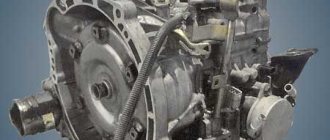At the end of the nineties of the last century, Toyota specialists began working on the creation of a CVT designed for front-wheel drive cars. In 2000, the transmission of the K310-K111 family appeared, which was subsequently produced in various modifications, distinguished by its reliability and versatility in use. CVT repair K310, K311, K312, K110, K111, K112, K410, XA-10LN, XA-15LN and timely service made it possible to operate such a transmission for half a million kilometers without undergoing a major restoration.
In 2000, the K110 variator model appeared, which was installed on Estims, Opahs, Corollas, Yaris.
Four years later, a modified variator was released, which received the index K111, and in 2005, a model with a reinforced K112 design appeared, which was installed on engines with a volume of up to 2.4 liters.
Soon modifications K114-K115 appeared, which had updated electronics and changed settings of the control unit.
In 2003, a series of mini-class CVTs was launched under the symbol K310, which were intended for engines with a volume of no more than 1.8 liters.
CVT modifications K410 and K411 were created especially for compact engines with a volume of up to 1.3 liters. They had a compact design, fully electronic control and were equipped with improved solenoids and a modified valve body.
The transmission of the XA-10LN and XA15-LN modifications was intended for foreign markets and was intended to replace the compact CVT modifications JF011E-JF015E.
Features of the variator K310, K311, K312, K110, K111, K112, K410, XA-10LN, XA-15LN
When designing such CVTs, Toyota engineers put practicality of use at the forefront, so such transmissions turned out to be more reliable than similar modifications of continuously variable transmissions from Jatko. This was achieved due to the clamped acceleration mode, which made it possible to prevent premature wear of the cones and belts. However, many car owners complained about the thoughtfulness of the transmission, which had to work in tandem with a small engine.
To solve the problem of slow acceleration, a direct shift gear design was used. But such an innovation significantly complicated the box layout, so repair of the variator K310, K311, K312, K110, K111, K112, K410, XA-10LN, XA-15LN and its service must be performed exclusively in specialized services, where the craftsmen are well aware of all the features of such transmissions.
Another feature of these options is the use of low-quality gaskets, which can cause frequent leaks of hydraulic fluid. This leads to increased wear, the oil pump suffers, there are problems with cooling the variator, and the gearbox develops critical malfunctions.
Toyota models with continuously variable transmission
The Toyota concern began using CVTs in 2000 on Opa cars, which were supplied to the Japanese domestic market. In Europe and North America, cars with CVT appeared only in 2009. The first were Avensis and Verso, equipped with a unified K311 unit with different control units. A year later, the experiment was extended to RAV4 crossovers with front-wheel drive or all-wheel drive. Toyota Corolla began to be equipped with a CVT only in 2013. The type of transmission can be determined by the text on the identification sticker, which contains information about the transmission model.
Since 2000, Toyota models have been produced with a continuously variable transmission.
Typical faults of the variator K310, K311, K312, K110, K111, K112, K410, XA-10LN, XA-15LN
The reliability of this variator and its service life will largely depend on whether the car owner follows the recommendations for car maintenance. In particular, it was necessary to completely eliminate car slipping or active dynamic driving with frequent acceleration to the floor. Typical faults include a problematic torque converter, leaking seals, a clogged heat exchanger, and worn iron, including sun gear bearings, belts and cones.
Torque converter restoration K310, K311, K312, K110, K111, K112, K410, XA-10LN, XA-15LN
The first problems with the torque converter and the need to perform scheduled repairs of the variator K310, K311, K312, K110, K111, K112, K410, XA-10LN, XA-15LN may appear already at about 100,000 kilometers. Most often, it is necessary to replace worn out Teflon rings, and their modifications may vary depending on the year of manufacture and the specific model of the variator. The clutches here are replaced as a set; such work must be performed at the first signs of their combustion.
To restore the torque converter, an appropriate repair kit is used, which somewhat simplifies such repair work. The car owner should contact the service in a timely manner. As soon as the car began to make the first knocks and kicks when transmitting power, the variator began to lag or slip; with such symptoms of malfunctions, you should immediately take the car to the workshop, have it diagnosed and repaired.
Cleaning the heat exchanger K310, K311, K312, K110, K111, K112, K410, XA-10LN, XA-15LN
The variator operates at critically high temperatures of the ATP fluid, and possible overheating can lead to rapid failure of the torque converter and contamination of the valve body with wear of the cones and belt. Prevention of such malfunctions is the timely replacement of transmission fluid and all disposable filters, as well as cleaning the heat exchanger. This radiator service is performed every 100 thousand kilometers, which makes it possible to remove chips and dense deposits that appear inside the cooler, leading to constant operation at high oil temperatures.
Wear iron K310, K311, K312, K110, K111, K112, K410, XA-10LN, XA-15LN
The weak point of this transmission is the sun gear bearings, which are subject to significant torsional loads during sudden acceleration or when using the automatic at high speeds. Toyota knew about this problem and tried to solve it by strengthening the gear bearings and making appropriate adjustments to the operation of the control unit, preventing increased load on the variator.
A planned overhaul of the K310, K311, K312, K110, K111, K112, K410, XA-10LN, XA-15LN variator may also include replacing a worn Bosch belt. Experts recommend checking them every 150 thousand kilometers. With a measured driving style, such a drive can last 300 thousand kilometers or more without replacement. To determine the condition of the drive, special tread notches are used. Using such marks, you can determine the need to replace the eaten belts, which prevents them from slipping when you press the gas pedal.
Also, under significant load during operation of the variator, wear and breakage of the Forward clutch drum is noted. Subsequently, this childhood illness was eliminated by making appropriate changes to the control unit. Also, the driver should avoid sudden aggressive acceleration in unheated oil, which leads to rapid wear of the cones, and their replacement is perhaps the most expensive repair of the variator K310, K311, K312, K110, K111, K112, K410, XA-10LN, XA-15LN .
Maintenance and repair of valve body K310, K311, K312, K110, K111, K112, K410, XA-10LN, XA-15LN
When performing a major overhaul, the hydraulic unit is serviced, which has a huge reserve of reliability for hardware. It is washed together with the solenoids, and the condition of the electric valves, which can become clogged with dirt due to a worn torque converter, is checked.
A special feature of this variator is the use of electric regulator bus solenoids instead of a classic step motor. Electric regulators are responsible for the correct transmission of power; they do not like hot and dirty oil, and if it is impossible to clean them, the entire valve body assembly must be replaced. Prevention of such malfunctions will be timely oil changes and routine maintenance of the hydraulic plate.
Advantages and disadvantages
Advantages of the variator noted by owners:
- smooth change in torque;
- reduced fuel consumption due to the optimal ratio of load and crankshaft speed;
- ease of driving.
Disadvantages indicated in reviews:
- the need for regular maintenance with replacement of fluid and filters;
- belt life does not exceed 150 thousand km;
- labor-intensive and expensive repairs;
- in case of breakdown, the car is immobilized;
- The unit is not designed to work with a trailer and quickly breaks down when slipping in snow or mud.
CVT repair K310, K311, K312, K110, K111, K112, K410, XA-10LN, XA-15LN
Scheduled repairs of the K310, K311, K312, K110, K111, K112, K410, XA-10LN, XA-15LN variator are performed every 150 thousand kilometers. As part of this work, the torque converter is restored, all gaskets are changed, the radiator is cleaned, and the condition of the belt and valve body is diagnosed. If you drive aggressively, you often need to change the bearings, and experts recommend replacing them as a set. When calling for service, they also check the wear of the Teflon rings, the condition of the clutches and the presence of burnt old oil in the machine.
This variator will need major repairs, depending on the style of driving the car, after a mileage of 200-300 thousand kilometers. Typically, such work involves replacing clutches with bearings, troubleshooting and replacing the belt, determining the condition of the cones and, if necessary, restoring them. The condition of the oil pump is checked; if it does not produce the required pressure in the system, its bushings, axle or the pump itself are changed. Also, the broken Forward clutch drum often required replacement, which was recommended to be replaced with revision reinforced spare parts.
Reviews of Toyota Rav 4 on CVT
Chobotar Viktor Vasilievich, 36 years old, Saransk
I bought a Rav 4 with a CVT three years ago. I don’t agree with those who say that the box won’t last long and will break. If you take care of it and change the oil and filter device on time, then it will travel more than 300,000 kilometers without major repairs. Like, for example, my swallow.
Kalmykov Kirill Vasilievich, 25 years old, Rubtsovsk
I bought Rav 4 7 years ago. During this time I accumulated two hundred thousand. I only changed the belt a couple of times and the oil four times. Of course, I took the car to a service center for preventive maintenance. They said the box looked like new. Overall a comfortable car for a family holiday.
Semenkin Mikhail Vitalievich, 30 years old, Cheboksary
I’ve been driving a Toyota Rav 4 for a long time. My family and I go on picnics, and I ride for work. Nice car and easy to drive. Acceleration picks up quite quickly without any jolts or jerks. I love. I've been to maintenance a couple of times. So far I have not had to restore the variator or send it for major repairs. I hope it lasts until I want to buy a new car. But I really like this one too.
Read more reviews about Rav 4 here.
How to increase the service life of the variator K310, K311, K312, K110, K111, K112, K410, XA-10LN, XA-15LN
This mini-class CVT did not withstand aggressive driving and increased loads well, so the car owner needed to practice a dimensional style of driving the car. It was mandatory to carry out scheduled repairs of the variator K310, K311, K312, K110, K111, K112, K410, XA-10LN, XA-15LN , and change the transmission oil with all disposable filters. In winter, sudden acceleration on a cold gearbox should be avoided, making sure to warm up the oil in the transmission after each overnight stop.
If it was necessary to repair the variator, you should contact specialized companies that have extensive experience working with such transmissions, using only original spare parts. The car owner should not neglect the symptoms of malfunctions that appear, which include slipping during acceleration, a drop in engine power, or extraneous sounds from the gearbox. By contacting the service in a timely manner, you can eliminate breakdowns at the initial stage, while avoiding the need to overhaul the variator.
Types of variators
Cone variators
Two cones, directed by tapering sections in different directions, connected by a belt. The most primitive type of such variators was used in mills in the 19th century. Much later, similar mechanisms began to be used on machine tools. There are a large number of cone variators: friction and with intermediate links, planetary, WEBO and others, each has found application in one area or another.
Toroidal variators
According to the principle of operation, these are friction variators that transmit force due to friction. There have been attempts to implement such boxes in the automotive industry, but for a number of reasons they have not received mass distribution. One example is the Extroid CVT from Jatco, which was installed on the 1999 Nissan Gloria.
The main assembly of the toroidal variator experiences enormous loads; the pressure in the contact patch of the rollers and disks can reach 10 tons. Therefore, high-carbon steel has to be used in production.
Lubrication of components under such loads is provided by special KTF oil, the cost of which reaches 20 thousand rubles per 4 liters. Due to the high cost of production and maintenance of such CVTs, they are very rare, at least for now.
V-belt variators
The most common type of CVT today, used not only in cars, but also in motorcycles, snowmobiles, and scooters.
The V-belt design contains:
- Variator unit with pulleys connected by a belt. Hydraulic pressure, centrifugal force or spring force are responsible for bringing the cones that form the pulleys closer together and apart;
- Forward and reverse clutches, necessary to change the direction of movement;
- Planetary mechanism responsible for turning on the reverse mode;
- A hydraulic unit that provides the necessary fluid pressure, its circulation and supply to the right places;
- An electronic control unit that combines and controls the operation of all individual variator mechanisms.
The belt itself, involved in the transmission of forces, can be called a belt with great stretch. This is a rather complex mechanism in design, consisting of many cone-shaped plates (up to 400 pieces) located on tapes.
Chain variators
This is the next stage in the development of CVTs, in which the belt is replaced by a chain, in order to extend service life. The structure of the chain is complex; it consists of many durable plates arranged in a checkerboard pattern. When used correctly, the chain has a longer service life and also transmits torque more efficiently. The transmission of forces is transmitted by the end surface of the chain.
Technical characteristics of Aisin TG-81SC
AWF8F35
| Type | hydraulic automatic machine |
| Number of gears | 8 |
| For drive | front/full |
| Engine capacity | up to 3.5 liters |
| Torque | up to 350 Nm |
| What kind of oil to pour | Toyota ATF WS |
| Lubricant volume | 6.6 l |
| Change of oil | every 100,000 km |
| Replacing the filter | once every 100,000 km |
| Approximate resource | 250,000 km |
AWF8F45
| Type | hydraulic automatic machine |
| Number of gears | 8 |
| For drive | front/full |
| Engine capacity | up to 4.5 liters |
| Torque | up to 480 Nm |
| What kind of oil to pour | Toyota ATF WS |
| Lubricant volume | 7.5 l |
| Change of oil | every 100,000 km |
| Replacing the filter | once every 100,000 km |
| Approximate resource | 250,000 km |
AWF8G45
| Type | hydraulic automatic machine |
| Number of gears | 8 |
| For drive | front/full |
| Engine capacity | up to 5.0 liters |
| Torque | up to 480 Nm |
| What kind of oil to pour | Toyota ATF WS |
| Lubricant volume | 7.5 l |
| Change of oil | every 120,000 km |
| Replacing the filter | once every 120,000 km |
| Approximate resource | 300,000 km |
What do we know about AISIN automatic transmissions?
The manufacturer's brand is registered in the country - Japan. The official website is located at: https://www.be.aisin-europe.com/ru-ru.
In June 2021, PartReview had a mixed opinion about AISIN automatic transmissions. PR score – 84 out of 100, based on 18 reviews and 57 votes. 14 reviews have a positive rating, 3 are neutral, and 1 is negative. The average review rating is 4 (out of 5). The votes were distributed as follows: 48 for, 9 against.
Gear ratios of automatic transmission TG81SC
Using the example of the 2021 Lexus RX350 with a 3.5 liter engine:
| home | 1st | 2nd | 3rd | 4th |
| 3.329 | 5.250 | 3.028 | 1.950 | 1.456 |
| 5th | 6th | 7th | 8th | Rear |
| 1.220 | 1.000 | 0.808 | 0.673 | 4.014 |
Similar transmissions from other manufacturers:
GM 9Т50 ZF 9HP28 ZF 9HP48
Which cars are equipped with the TG-81SC box?
Toyota
| Camry XV70 | 2017 – present |
| Avalon XX50 | 2018 – present |
| Sienna XL30 | 2017 – present |
| Highlander XU50 | 2016 – present |
Lexus
| RX AL10 | 2013 – 2015 |
| RX AL20 | 2015 – present |
Volvo
| S60 1 | 2015 – 2018 |
| S80 1 | 2014 – 2016 |
| S90 1 | 2016 – present |
| XC40 1 | 2017 – present |
| XC60 1 | 2014 – 2017 |
| XC60 1 | 2017 – present |
| XC90 1 | 2015 – present |
| V90 1 | 2016 – present |
BMW
| X1 F48 | 2015 – present |
| 2-Series F45 | 2014 – present |
Mini
| Clubman F54 | 2015 – present |
Opel
| Insignia B | 2017 – present |
Chevrolet
| Malibu 9 | 2015 – present |
Cadillac
| XT5 | 2017 – present |
Volkswagen
| Crafter | 2016 – present |











